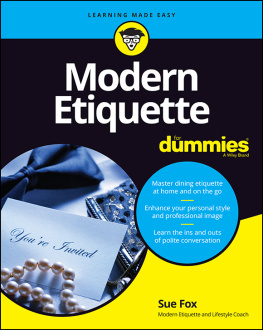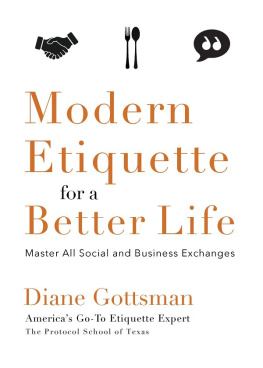This edition could not have come to be without the support and help of many polite people whose positive behavior has served as a beacon of civility, my family who know good manners is a journey and not necessarily a destination, my friends who bring me fabulous faux pas examples from their personal and professional lives, and the thousands of people who have participated in my seminars, written to me via the Web and engaged with me via social media.
INTRODUCTION
Have you ever noticed that there are some people to whom you take an instant liking? You enjoy speaking with them and look forward to seeing them again. Being with them actually makes you feel better about yourself. Conversely, there are those who make you feel uncomfortable whenever youre around them. While you may not be able to put your finger on the exact reason, as soon as you start talking to such a person, you wish that you were somewhere else. Often, these reactions are caused by the other individuals mastery of social guidelines.
Understanding how to behave in different situations is key to being a class act. The refined gentleman is comfortable in a variety of environments and is able to make those around him comfortable as well. While it may seem as though he has some inherent capability for knowing exactly how to behave in different situations and how to interact with different individuals, this is not the case. In fact, the big secret is that people are not born with charm; it is actually a learned skill. And it is not a difficult one. While etiquette may seem like a daunting subject, its really quite simple, centering upon respect, consideration for others, and common sense. This means that with a bit of reading and a little practice, you too can know just what to say and do in all sorts of circumstances. You too can be a class act.
Becoming a class act is not only a relatively simple goal to achieve, but also an important one. Our abilities in a whole range of areas are generalized based upon the social behaviors we exhibit. Whether you are interviewing for a new job, building your business, or seeking new social relationships, manners matter.
This book contains a number of etiquette guidelines to help you navigate some of the most common interactions. Please note that I use the word guidelines deliberately. Contrary to popular belief, etiquette is not about rules. I never speak of etiquette in terms of rules because for every etiquette rule, I can think of an exception (or two or three). Guidelines allow for variation. Guidelines understand that behaviors are situationally specific. For instance, while you would of course use a fork and knife when dining out at a fancy restaurant, you wouldnt think twice about using your fingers when eating pizza with your family at home. It is important to understand not only what the etiquette guidelines are, but also when and how to apply them.
It is my hope that you will use this book in two ways. First, that you are enthralled enough to sit down with a refreshing drink and read it cover to cover. Second, that you will keep it on hand to refer to as etiquette issues arise. If you encounter etiquette emergencies outside of the topics covered in this book, please contact me via the Mannersmith website: www.mannersmith.com.
I hope you find this book both educational and entertaining.
CHAPTER ONE
PUBLIC PLACES and EVENTS
YOU MAY BE SURPRISED TO HEAR THAT its alright to hang out in your sweatpants, watch television, and eat dinner from a take-out containeras long as youre home alone. Everyone, of course, needs a little downtime now and then to unwind. But if you plan to interact with others, this m.o. is not the best way to make friends or impress others. When hitting the town, youll need to modify both your behavior and your clothes.
RESTAURANTS
DRESS TO DINE: Your clothing should match the formality of the restaurant. At some fine-dining establishments, youll be required to wear a jacket and tie. Check the website or call ahead so that youre dressed appropriately.
AVOID THE WAIT: Whenever possible, make a reservation. Investing a few moments in this simple step could save you an hour or so once you actually arrive at the restaurant, which may not be able to accommodate you in a timely fashion without advance notice (in fact, some popular venues may not be able to seat you at all if you dont make a reservation). Some social media reservation sites will allow you to earn points toward priority seating or other dining perks.
HOLD YOUR HORSES: Even when you do have a reservation, there are instances in which you may still need to wait for your table (there are all sorts of unpredictable variables involved, and not all establishments have the timing down to an exact science). If you find yourself in this situation, visit the bar, take a walk around the block, or peruse the menu. If after fifteen minutes your table still isnt ready, ask the matre din a respectful tonehow much longer he expects the wait to be. Do not make a scene, as this rarely helps.
DONT FLASH THE CASH: In the movies and many sitcoms, the characters will wave some money beneath the nose of the matre d to speed up the seating process. In real life, this rarely works. Whats more, youll simply be identifying yourself as a heathen since tipping is always done discreetly.
MAY I TAKE YOUR COAT? If you are with a date, a female relative, or an unescorted woman in a social situation and the restaurant has a coat check, ask this female companion if shed like to check her coat. To help a woman take off this garment, stand behind her, gently but firmly grasp the shoulder seam of the coat with both hands, lift it up slightly above her shoulders, and then bring it down so that the sleeves slide off her arms. Fold the garment lengthwise, and hand it to the attendant. Note that when a woman is sporting a fur coat, shell wear it to the table, take her seat, and shrug the fur off her shoulders onto the back of the chair. You should help her into her chair (see below), but she will shrug the coat off herself.













